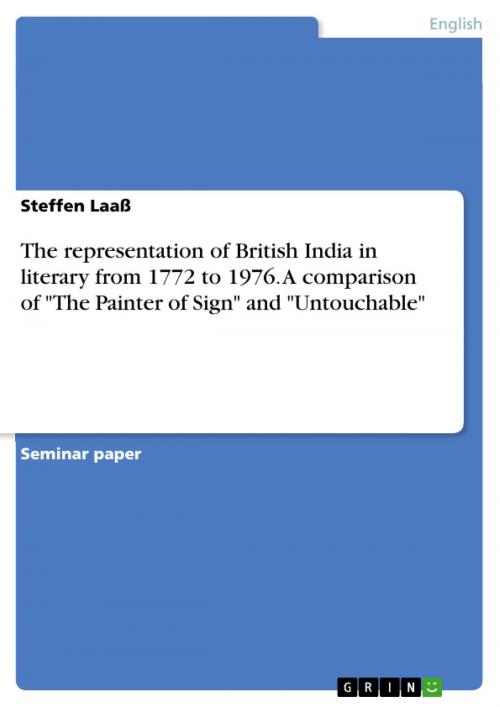The representation of British India in literary from 1772 to 1976. A comparison of 'The Painter of Sign' and 'Untouchable'
Fiction & Literature, Anthologies| Author: | Steffen Laaß | ISBN: | 9783640152308 |
| Publisher: | GRIN Publishing | Publication: | September 2, 2008 |
| Imprint: | GRIN Publishing | Language: | English |
| Author: | Steffen Laaß |
| ISBN: | 9783640152308 |
| Publisher: | GRIN Publishing |
| Publication: | September 2, 2008 |
| Imprint: | GRIN Publishing |
| Language: | English |
Seminar paper from the year 2005 in the subject English Language and Literature Studies - Comparative Literature, grade: 1,3, University of Nottingham (English Studies), course: Literature on British India, 11 entries in the bibliography, language: English, abstract: The legacy of British colonialism in India is not only of economic or social nature, but also of highly literary interest. What makes the literature of British India so fascinating is first and foremost its depiction of the 'other', the exotic and unknown. On the basis of selected representative texts by both British and Indian writers, this essay attempts to set out visible similarities and differences in Anglophone literature on India. To this end, Anand's Untouchable and Narayan's The Painter of Signs shall serve as core texts around which the comparisons will be centred. It must be noted that representations of India do not embrace people alone, even though this is one of them most interesting and exhaustive aspects. Elements I will also elaborate on are the representations of landscapes and stereotypical images of India. As far as the British are concerned, it is the colonizers that are of primary interest here. The literary material we will be discussing covers a period of more than 200 years - from 1772 to 1976. But it was only in 1978 when Edward Said published his most influential book Orientalism which studies the East through Western eyes. His vies will be used as a starting point for our investigation.
Seminar paper from the year 2005 in the subject English Language and Literature Studies - Comparative Literature, grade: 1,3, University of Nottingham (English Studies), course: Literature on British India, 11 entries in the bibliography, language: English, abstract: The legacy of British colonialism in India is not only of economic or social nature, but also of highly literary interest. What makes the literature of British India so fascinating is first and foremost its depiction of the 'other', the exotic and unknown. On the basis of selected representative texts by both British and Indian writers, this essay attempts to set out visible similarities and differences in Anglophone literature on India. To this end, Anand's Untouchable and Narayan's The Painter of Signs shall serve as core texts around which the comparisons will be centred. It must be noted that representations of India do not embrace people alone, even though this is one of them most interesting and exhaustive aspects. Elements I will also elaborate on are the representations of landscapes and stereotypical images of India. As far as the British are concerned, it is the colonizers that are of primary interest here. The literary material we will be discussing covers a period of more than 200 years - from 1772 to 1976. But it was only in 1978 when Edward Said published his most influential book Orientalism which studies the East through Western eyes. His vies will be used as a starting point for our investigation.















